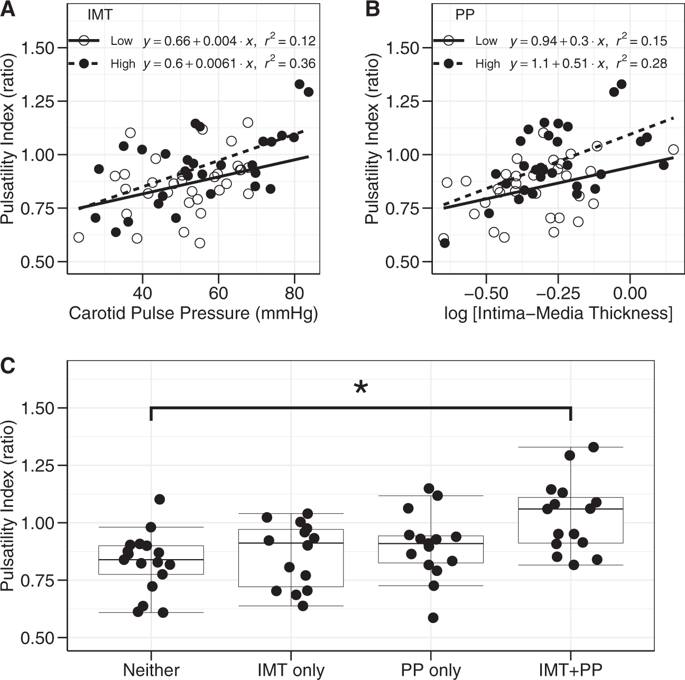Journal of Human Hypertension ( IF 2.7 ) Pub Date : 2019-12-10 , DOI: 10.1038/s41371-019-0295-7 Andrew D Robertson 1 , George A W Heckman 1, 2 , Myra A Fernandes 1, 3 , Eric A Roy 1, 3 , Suzanne L Tyas 2 , Richard L Hughson 1

|
Vascular aging is associated with markers of cerebrovascular impairment. Whether discrete characteristics of arterial structure and function have independent and/or additive effects on cerebral hemodynamics, however, is not completely understood. We examined the association of cerebral hemodynamics with common carotid artery intima-media thickness (IMT) and pulse pressure (PP) in 61 older adults with prevalent cardiometabolic risk but no history of cerebrovascular disease. We calculated pulsatility index (PI) and hypercapnic reactivity of the middle cerebral artery, as well as global blood flow through the extracranial arteries. The dominant effects were related to hemodynamic pulsatility. In adults with metabolic syndrome, PI was related to IMT (r = 0.48, P = 0.003) after adjustment for age and sex. Without metabolic syndrome, PI was directly related to PP (r = 0.63, P = 0.003). Across the whole cohort, PP [β (95%CI) = 0.42 (0.18, 0.67), P = 0.001] and IMT [0.42 (0.18, 0.67), P < 0.001] remained significant predictors of PI, after accounting for individual cardiometabolic risk factors. The independent and combined effects of IMT and PP were tested by binarizing PP and IMT at the sample median. Participants with both IMT and PP above their respective medians had elevated PI compared with those with both vascular markers below the median [median (interquartile range) = 1.06 (0.22) vs. 0.84 (0.14), P = 0.003)]. PI was not different from the low risk group if only one of IMT or PP were above the median. Although overall vascular burden was low, moderate associations with PI persisted, suggesting pulsatile characteristics represent one of the earliest markers linking vascular aging to changes in brain health.
中文翻译:

颈动脉脉压和内膜中层厚度与社区老年人的脑血流动力学搏动独立相关
血管老化与脑血管损伤的标志物有关。然而,动脉结构和功能的离散特征是否对脑血流动力学具有独立和/或累加的影响尚不完全清楚。我们检查了 61 名具有普遍心脏代谢风险但没有脑血管疾病史的老年人的脑血流动力学与颈总动脉内中膜厚度 (IMT) 和脉压 (PP) 的关联。我们计算了大脑中动脉的搏动指数 (PI) 和高碳酸血症反应性,以及通过颅外动脉的整体血流量。主要影响与血流动力学搏动有关。在代谢综合征成人中,PI 与 IMT 相关(r = 0.48,P = 0.003) 调整年龄和性别后。在没有代谢综合征的情况下,PI 与 PP 直接相关(r = 0.63,P = 0.003)。在整个队列中,PP [β (95% CI) = 0.42 (0.18, 0.67), P = 0.001] 和 IMT [0.42 (0.18, 0.67), P < 0.001] 仍然是 PI 的重要预测因子,考虑到个体心脏代谢风险因素。IMT 和 PP 的独立和组合效应通过在样本中位数处对 PP 和 IMT 进行二值化来测试。与两个血管标志物均低于中位数的参与者相比,IMT 和 PP 均高于各自中位数的参与者的 PI 升高 [中位数(四分位距)= 1.06 (0.22) vs. 0.84 (0.14),P = 0.003)]。如果只有 IMT 或 PP 之一高于中位数,则 PI 与低风险组没有区别。尽管总体血管负担较低,但与 PI 的中等关联仍然存在,这表明搏动特征是最早将血管老化与大脑健康变化联系起来的标志之一。











































 京公网安备 11010802027423号
京公网安备 11010802027423号